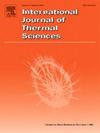Icing characteristics of supercooled sessile water droplets on the top of cold micro-pillars
IF 4.9
2区 工程技术
Q1 ENGINEERING, MECHANICAL
International Journal of Thermal Sciences
Pub Date : 2025-03-17
DOI:10.1016/j.ijthermalsci.2025.109871
引用次数: 0
Abstract
Icing and frosting problems on cold surfaces affect the normal operation of equipment and optimizing the anti-icing and ice-phobic properties of structured surfaces needs exploration of the droplet icing process on typical micro-pillars. Based on the apparent heat capacity method, the icing characteristics of sessile water droplets on the top of cold micro-pillars are numerically studied with the supercooling degree considered. The effects of the micro-pillar diameter and height as well as the droplet volume and surface temperature are obtained. As the micro-pillar diameter becomes smaller, the icing rate of the droplet decreases and the freezing time increases. A higher micro-pillar enlarges the thermal resistance, slows down the movement of the freezing front, and results in an increase in the freezing time. The freezing time goes up as the droplet volume and the surface temperature increase. This changing trend becomes more conspicuous for a smaller micro-pillar diameter. Furthermore, the relationship between the freezing time and the micro-pillar diameter and height is derived from heat transfer analysis. The freezing time is negatively related to the square of the micro-pillar diameter. When the micro-pillar height increases one time, the droplet freezing time will increase by 3.42 %. The findings in this work give insights into the icing mechanism of supercooled sessile water droplets on the top of cold micro-pillars and provide references for the design and optimization of anti-icing and anti-frosting surfaces.
冷表面的结冰和结霜问题影响设备的正常运行,优化结构表面的防结冰和疏冰性能需要对典型微柱上的液滴结冰过程进行探索。基于视热容法,在考虑过冷度的情况下,对冷微柱顶部固结水滴的结冰特性进行了数值研究。得到了微柱直径、微柱高度、微滴体积、微滴表面温度等因素的影响。微柱直径越小,液滴结冰速率越小,冻结时间越长。微柱越高,热阻越大,冻结锋移动速度越慢,冻结时间越长。冻结时间随着液滴体积和表面温度的升高而增大。微柱直径越小,这种变化趋势越明显。通过传热分析,推导了冻结时间与微柱直径和微柱高度的关系。冻结时间与微柱直径的平方成负相关。微柱高度增加1倍,液滴冻结时间增加3.42%。研究结果揭示了冷微柱顶部过冷固滴结冰机理,为防冰、防霜表面的设计与优化提供了参考。
本文章由计算机程序翻译,如有差异,请以英文原文为准。
求助全文
约1分钟内获得全文
求助全文
来源期刊

International Journal of Thermal Sciences
工程技术-工程:机械
CiteScore
8.10
自引率
11.10%
发文量
531
审稿时长
55 days
期刊介绍:
The International Journal of Thermal Sciences is a journal devoted to the publication of fundamental studies on the physics of transfer processes in general, with an emphasis on thermal aspects and also applied research on various processes, energy systems and the environment. Articles are published in English and French, and are subject to peer review.
The fundamental subjects considered within the scope of the journal are:
* Heat and relevant mass transfer at all scales (nano, micro and macro) and in all types of material (heterogeneous, composites, biological,...) and fluid flow
* Forced, natural or mixed convection in reactive or non-reactive media
* Single or multi–phase fluid flow with or without phase change
* Near–and far–field radiative heat transfer
* Combined modes of heat transfer in complex systems (for example, plasmas, biological, geological,...)
* Multiscale modelling
The applied research topics include:
* Heat exchangers, heat pipes, cooling processes
* Transport phenomena taking place in industrial processes (chemical, food and agricultural, metallurgical, space and aeronautical, automobile industries)
* Nano–and micro–technology for energy, space, biosystems and devices
* Heat transport analysis in advanced systems
* Impact of energy–related processes on environment, and emerging energy systems
The study of thermophysical properties of materials and fluids, thermal measurement techniques, inverse methods, and the developments of experimental methods are within the scope of the International Journal of Thermal Sciences which also covers the modelling, and numerical methods applied to thermal transfer.
 求助内容:
求助内容: 应助结果提醒方式:
应助结果提醒方式:


